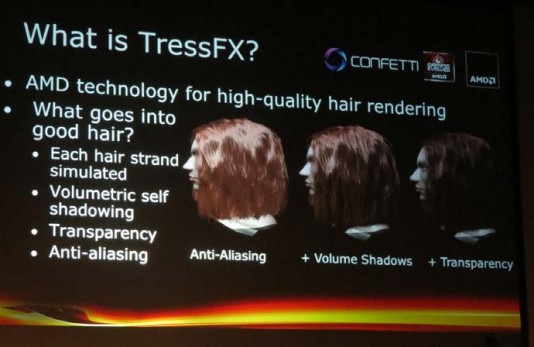Presentation at FMX goes into depth on Lara Croft’s hair
By Kathleen Maher
At the recent FMX conference in Germany, AMD teamed up with Confetti Interactive to describe their collaboration to create realistic hair for Lara Croft in Tomb Raider. Seems the old girl needed a makeover. AMD’s Stephen Hodes, the development relations engineer, talked about the opportunity AMD saw in helping accelerate a system for better hair, and he and Confetti’s CEO Wolfgang Engel explained how it was done. Engel went into detail on the rendering of Lara’s hair.

Hodes talked about how the technology of hair has such an outsized effect on “selling” a character, and well, Lara was ready for an update. The franchise is pretty ancient, released in 1996 and originally developed by Core Design. The game had some years of wild success, but gradually it ran out of steam—a stinker of a movie starring Angelina Jolie probably didn’t help. Eidos used its subsidiary Crystal Dynamics in 2006 to update Lara Croft, and Legend was released in 2006. The follow-up, Anniversary, was not a world-burner, and Underworld in 2008 fared even worse. In 2009, Eidos was acquired by Square Enix, so they’re not all part of the family.
The latest Tomb Raider game brought the game’s original designer, Toby Gard, who had big visions for Lara as a strong female character. He was undermined by the forces of marketing, which played up Lara’s outsized assets—or so the legend goes. For this version, Crystal Dynamics brought in Confetti to do something a little special. Confetti styles itself as a “think tank” for the entertainment content creation industry. They develop their own middleware applications and have created GPU-accelerated applications for games, movies, and tools for GPU companies.
So, to get back to Tomb Raider, the newest game is framed as a return to the origins of the game everyone loved. She’s been remodeled with more realistic movement and dimensions, and the team decided they’d pull out the stops to give Lara the most realistic hair ever. For this they relied on PC technology, using DirectCompute, and worked heavily with AMD.
The team was able to get started with off-the-shelf tools including Shave and a Haircut, a Maya plug-in by Joe Alter. The most basic part of the trick was going for volume. They used 4,737 guide hairs for render and created 7,014 source splines, which were then duplicated and offset and in the end created 21,042 splines with 16 vertices per spline. That’s a lot of hair for digital, but for reference, you’ll be interested to know we have a lot more hair on our heads than Lara. We’re told that blondes average about 140,000 strands, brunettes average 108,000, and redheads make do with 90,000. The segments of each hair had a parent-child relationship down the strand, which responded using inverse kinematics with constraints added for the hair’s at-rest position. The hair is plenty lively as it is, and the presenters said Lara experienced some really bad hair days before they figured out how to get it all working together.

Lara’s hair was organized into Bangs, Caps, Fringe, and Ponytail. The team then created simulations to consider gravity, wind, and other dynamic forces. They used collision detection for the hair to interact with itself in a realistic way. The simulations were computed once on the CPU, updates are handled for each frame on the GPU, and all the data resides in the GPU. The update of a strand is serial, but the updates of all the strands run independently and in parallel, as you’d expect for decent-looking hair.
For rendering, each hair was individually texture mapped and rendered with anti-aliasing. They used alpha-blending to blend the hair into the frame buffer. Different lighting systems were used for the tips of hair and hair closer to the scalp. Self-shadowing effects added to the realism. The team was able to use a standard shadow map approach and approximated darker values for hair closer to the skull and brighter values at the tips. Artists were given access to 50 different sliders to control the look and simulation of hair, and there are different options to create wet hair and dry hair. As you can imagine, poor Lara is exposed to every miserable weather condition imaginable, and apparently her hair responds appropriately.
AMD has been working on technology used in this project called order-independent transparency, and it has been discussed in Siggraph papers including papers delivered in 2012 by Xuan Yu. More detail on that work can be found online. Also, Wolfgang Engle has provided his slides on Slideshare. They’re really enlightening.
Our turn
Lara’s hair has been an inspiration. Forbes has run a feminist meditation on the role of Lara Croft in modern myth-making by Caroline Pinchefsky. But also, we believe it is evidence of new inspiration from AMD. The graphics team put considerable work into this technology, and part of the reason is to demonstrate that all graphics boards can produce amazing effects today using modern and open technologies like OpenCompute. AMD is not saying you need an AMD board to run Tomb Raider on a PC for the best effect. No, they’re saying all DirectX 11 boards can run the effect and the board with the best performance will run the best. Isn’t that kind of refreshing?





